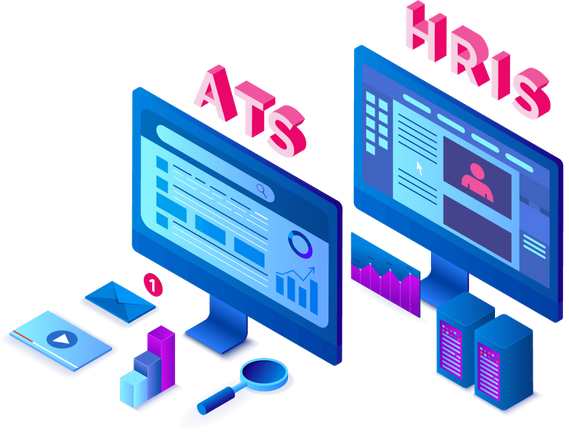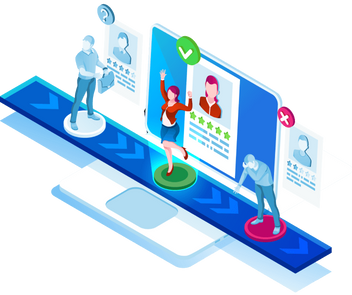The difference between ATS and HRIS

Most medium and large-sized organizations use one or both systems during recruitment. What’s the difference between these solutions? And in which situations do you need to use one over the other? We compare and contrast HRIS and applicant tracking systems and explore when you may want to use one over the other.
An HRIS is a human resource information system. It is a software suite used to track organizational policies, manage human resource processes, and maintain employee records. Typically, an HRIS assists in managing employee data, payroll, benefits administration, and performance management.
ATS vs HRIS, what’s the difference?
These systems are used at different stages of the candidate-employee journey and manage different data sets.
Applicant Tracking Systems
- Collect, store, and manage candidate data like employment history, testing scores, interview ratings, notes from interviewers, and references
- Streamline the hiring process by automating administrative tasks (for example, scheduling interviews or pre-screening candidates)
- Facilitate team collaboration and coordinate hiring decision-making
- Focus on the candidate experience and include candidate relationship management tools to nurture talent
- Plug in to hiring tools like interview software
- Support onboarding by continuing to engage new hires and plugging in background check platforms and HRIS/payroll tools
Human Resource Information Systems
- Collect, store, and manage employee data like position, salary, vacation banks/requests, and emergency contact(s)
- Streamline employee training and development, absence management, and performance measurement
- Facilitate internal development and workforce planning decisions by storing all employee information in one place
- Monitor ongoing compliance with regulatory changes
- Provide a positive employee experience by making it easier to enroll in health benefits through self-service functions
- Support onboarding by conducting background checks and providing new hires with self-service features to reduce paperwork
Is it really a question of one over the other? No. Organizations should use both to benefit from features and capabilities specific to either recruitment or employee management.
ATS vs HRIS, which system do you need?
Boosting talent acquisition:
One of the key differences between these two systems is that most HRIS focus on managing personnel rather than talent acquisition. In a competitive market where the employee-employer relationship dynamic has shifted in recent years, acquisition strategies are increasingly on the rise.
An applicant tracking system is designed with candidate sourcing and nurturing in mind. It offers features that can help employers efficiently and effectively source new talent:
Custom careers page
Tailored branding, messaging, and even IP detection to attract applicants
Job board integration
The ability to post to and manage multiple job boards at the same time
Saved talent pools
Searchable talent pools, including past applicants who may have relevant skills
Passive candidate sourcing
Email and social campaigns to engage candidates with hard-to-find skill sets
When determining which job boards to market on, consider the alignment between the job board’s audience demographic and the position you are looking to fill. Also consider the boards’ geographical reach, cost, and additional features offered. One-click apply is increasingly appealing to applicants for hourly positions.
Creating employee referral programs:
As part of talent acquisition strategies, having a strong referral program can help increase candidate and brand alignment, improve retention rates, and improve the overall quality of hires.
For the retail and hospitality industries, in particular, employee referrals help boost top-of-funnel applications and reduce time-to-hire by providing an ongoing roster of new candidates.
An applicant tracking system offers advantages over an HRIS in creating a referral program:
- Employees can easily share new job postings with their networks, including on social media
- Employees can similarly upload their referral’s resume and contact information into the platform with just a few clicks
- Employers can create staff-focused campaigns and incentive referrals to increase engagement
- It provides transparency and gives employees the ability to track the progress of their referrals and their potential rewards
- The same filtering features that recruiters use to search for relevant skills and work experience can be used to filter candidates who came in as referrals
- HR can easily track and measure referrals and combine with other hiring metrics to understand best candidate sources, time-to-hire, and quality of hires
New hire workspace set-up:
Getting new hires up and running quickly is paramount in a hybrid and remote work landscape. Are they set up with all of the technology and applications needed for their role?
What’s the difference between these two systems during set-up? An HRIS can help employers set new hires up for success before their start date. An HRIS can also facilitate background checks and payroll enrollment.
The onboarding experience:
Self-service features in an HRIS give new hires a streamlined, paperless experience when onboarding.
One limitation, however, is that HRISs don’t always offer communication features to stay in touch with new hires before their start date. For example, welcome communications and packages.
Scaling operations:
As an organization grows, standardization and compliance in recruitment and employment practices become more important. Companies should consider using both systems when scaling operations.
During recruitment:
An applicant tracking system creates a consistent hiring process through automated workflows. Some system vendors also offer structured interviewing as a plug in. This helps employers create a standardized, repeatable process, which can help support fair for hiring practices.
Some systems can be customized to support your ideal hiring processes that promote DEI across all hiring initiatives. For example, tailoring the system’s workflows to facilitate panel reviews of an applicant’s resume and pre-recorded interview responses in order to aggregate feedback from multiple points of view.
Post-hire:
The difference between an ATS and HRIS during post-hire is that an HRIS creates consistency around training, performance and promotional opportunities, and new hire set-up. For example, companies can standardize HRIS self-service features for new hires.
Your software choice matters! Recent hiring statistics reveal: The average time-to-fill for open positions is 42 days. 60% of job seekers abandon online applications midway through and 78% of companies state that an ATS makes the hiring process easier.
Other helpful resources
What are the different types of ats?
ATS features – by company size and industry
Candidate tracking systems to manage talent sourcing
What are the best ats for 2023?
Frequently asked questions
What are the benefits of an ATS?
For employers, it reduces time-to-hire and eliminates the need for paperwork, spreadsheets, and back-and-forth communications. It also helps improve the quality of hires by creating a wider pool of applicants, introducing advanced screening capabilities, and improving hiring team collaboration.
For candidates, it creates a positive experience with a fast, easy application process, flexible scheduling options, and prompt communications throughout their journey.

What are some common features?
Common features that leverage advanced automation include:
- Scheduling;
- Resume screening/filtering;
- Candidate advancement;
- Ongoing candidate tracking;
- Timed SMS and email communications; and
- Weighted applicant scoring.
Why is an ATS important?
Its primary purpose is to streamline the hiring process for employers so that they can focus their time and resources on higher-value tasks such as spending time with qualified candidates. It also helps establish standardized hiring practices and to maintain data integrity and compliance.
Which companies are using an ATS?
Most medium and large-sized companies use one during recruitment. Some organizations use the same platform for all hiring stages, while others use advanced integration to plug in to various HR tech tools at different points.
With data-driven decision-making becoming increasingly important, it’s likely that more companies of all sizes will continue to implement one in their hiring process.